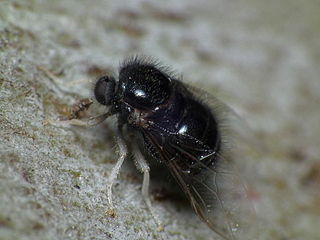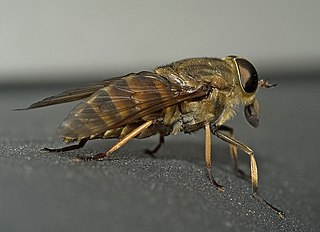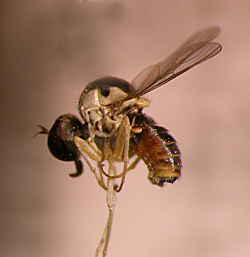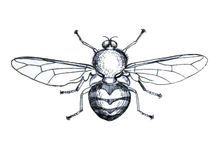Hypermetamorphosis, or heteromorphosis, is a term used in entomology that refers to a class of variants of holometabolism, that is to say, complete insect metamorphosis, but where some larval instars are distinct from each other.

The Bombyliidae are a family of flies. Their common name are bee flies or humbleflies. Adults generally feed on nectar and pollen, some being important pollinators. Larvae generally are parasitoids of other insects.

The Asilidae are the robber fly family, also called assassin flies. They are powerfully built, bristly flies with a short, stout proboscis enclosing the sharp, sucking hypopharynx. The name "robber flies" reflects their notoriously aggressive predatory habits; they feed mainly or exclusively on other insects and as a rule they wait in ambush and catch their prey in flight.

The Acroceridae are a small family of odd-looking flies. They have a hump-backed appearance with a strikingly small head, generally with a long proboscis for accessing nectar. They are rare and not widely known. The most frequently applied common names are small-headed flies or hunch-back flies. Many are bee or wasp mimics. Because they are parasitoids of spiders, they also are sometimes known as spider flies.

A planidium is a specialized form of insect larva seen in the first-instar of a few families of insects that have parasitoidal ways of life. They are usually flattened, highly sclerotized (hardened), and quite mobile. The function of the planidial stage is to find a host on which the later larval instars may feed, generally until the insect pupates.

The Brachyceran infraorder Tabanomorpha is a small group that consists primarily of two large families, the Tabanidae and Rhagionidae, and an assortment of very small affiliated families, most of which have been included within the Rhagionidae. The Tabanomorpha is one of the two Brachyceran groups outside the Hippoboscoidea that contain blood-feeding (hematophagous) species, though they are not important disease vectors.

The Brachyceran infraorder Muscomorpha is a large and diverse group of flies, containing the bulk of the Brachycera, and, most of the known flies. It includes a number of the most familiar flies, such as the housefly, the fruit fly, and the blow fly. The antennae are short, usually three-segmented, with a dorsal arista. Their bodies are often highly setose, and the pattern of setae is often taxonomically important.

British Soldierflies and their allies is a book by Alan E. Stubbs and Martin Drake, published by the British Entomological and Natural History Society in 2001. A second edition was published in 2014.
The larger brachycera is a name which refers to flies in the following families of the suborder Brachycera:

Rhagionidae or snipe flies are a small family of flies. They got their name from the similarity of their often prominent proboscis that looks like the beak of a snipe.

Mythicomyiidae, commonly called mythicomyiids, are very tiny flies (0.5–5.0 mm) found throughout most parts of the world, especially desert and semi-desert regions, except the highest altitudes and latitudes. They are not as common in the tropics, but genera such as Cephalodromia and Platypygus are known from these regions. Many of these "microbombyliids" have a humpbacked thorax and lack the dense vestiture common in the Bombyliidae. Mythicomyiids have until recently not had much attention in the literature. Their small size has caused them to be missed when collecting. Yellow pan trapping and fine-mesh netting in Malaise and aerial sweep nets has resulted in a number of undescribed species from many parts of the world. A high diversity of both genera and species exists for this family in Africa, especially northern and southern portions. About 350 species are known. Hundreds more await description.

Nemestrinidae, or tangle-veined flies is a family of flies in the superfamily Nemestrinoidea, closely related to Acroceridae. The family is small but distributed worldwide, with about 300 species in 34 genera. Larvae are endoparasitoids of either grasshoppers (Trichopsideinae) or scarab beetles (Hirmoneurinae). Some are considered important in the control of grasshopper populations. Adults are often observed on flowers.
The Diptera is a very large and diverse order of mostly small to medium-sized insects. They have prominent compound eyes on a mobile head, and one pair of functional, membraneous wings, which are attached to a complex mesothorax. The second pair of wings, on the metathorax, are reduced to halteres. The order's fundamental peculiarity is its remarkable specialization in terms of wing shape and the morpho-anatomical adaptation of the thorax – features which lend particular agility to its flying forms. The filiform, stylate or aristate antennae correlate with the Nematocera, Brachycera and Cyclorrhapha taxa respectively. It displays substantial morphological uniformity in lower taxa, especially at the level of genus or species. The configuration of integumental bristles is of fundamental importance in their taxonomy, as is wing venation. It displays a complete metamorphosis, or holometabolous development. The larvae are legless, and have head capsules with mandibulate mouthparts in the Nematocera. The larvae of "higher flies" (Brachycera) are however headless and wormlike, and display only three instars. Pupae are obtect in the Nematocera, or coarcate in Brachycera.
Diptera is an order of winged insects commonly known as flies. Diptera, which are one of the most successful groups of organisms on Earth, are very diverse biologically. None are truly marine but they occupy virtually every terrestrial niche. Many have co-evolved in association with plants and animals. The Diptera are a very significant group in the decomposition and degeneration of plant and animal matter, are instrumental in the breakdown and release of nutrients back into the soil, and whose larvae supplement the diet of higher agrarian organisms. They are also an important component in food chains.

Acrocera orbiculus, also known as the top-horned hunchback, is a species of fly belonging to the family Acroceridae. The species has a holarctic distribution, ranging from North America to the Palaearctic.

Sabroskya is a genus of small-headed flies in the family Acroceridae. It is known from South Africa and Malawi. It is named after the American entomologist Curtis Williams Sabrosky.
Corononcodes is a genus of small-headed flies. It is known from South Africa and the Palearctic realm.

Ogcodes gibbosus is a Palearctic species of fly in the family Acroceridae.

Ogcodes pallipes is a Palearctic species of fly in the family Acroceridae.
Rhagionemestriidae is an extinct family of brachyceran flies known from the Jurassic and Cretaceous periods. It was first named as a subfamily of the Nemestrinidae by Ussatchov (1968), and was raised to full family status by Nagatomi and Yang (1998). They are considered to be closely related to the family Acroceridae. Similar to Acroceridae, members of the family possess a large hemispherical head, with eyes covering nearly all of the area.













